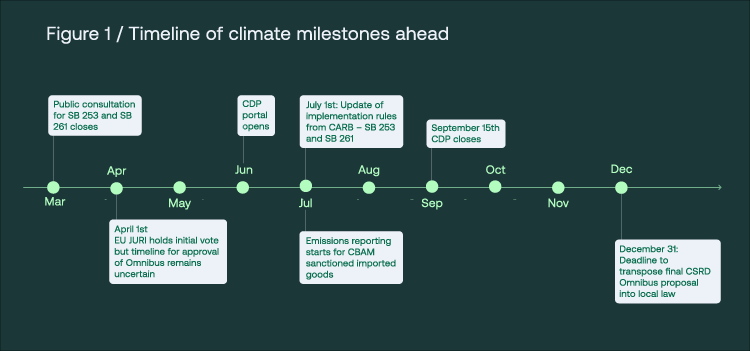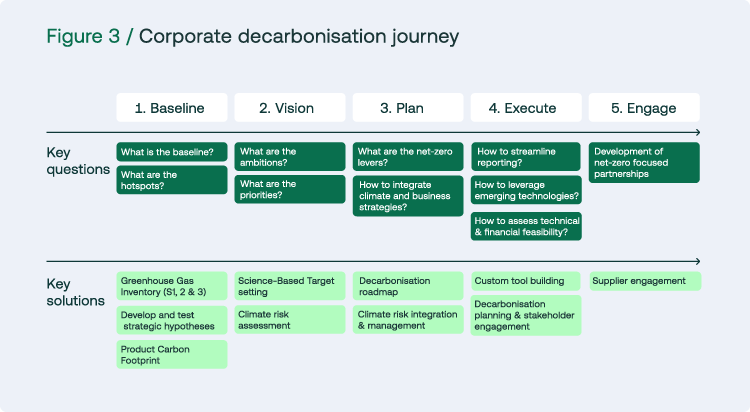Why climate action can’t wait
As the new year unfolds, it’s clearer than ever: climate change isn’t a distant problem. From extreme weather to rising sea levels, the effects are already here—and businesses need to respond. Today, a sustainability strategy isn’t just “nice to have.” It’s key to long-term success, helping manage risk, meet regulations, and build trust.
Stakeholders across the board—investors, customers, employees, and regulators—are looking closely at how companies address climate and sustainability:
- Investors expect transparency and real action.
- Customers reward sustainable brands.
- Employees want to work for companies that share their values.
- Governments are tightening regulations with new climate disclosure rules, emissions limits, and carbon pricing.

So how do you prepare? Let’s walk through six clear steps to build a resilient ESG (Environmental, Social, and Governance) strategy that helps your business grow sustainably.
6 Practical steps to a stronger ESG strategy

Step 1: put climate governance in place
A strong climate strategy starts with the right people and structure. This means assigning clear roles and creating systems that support smart, sustainable decisions at every level of your business.
Try this:
- Set up a sustainability committee or name a Chief Sustainability Officer (CSO).
- Include climate discussions in board meetings.
- Create policies based on global standards like TCFD.
Quick tip: Start simple if you’re new to ESG. If you’re more advanced, focus on integrating climate KPIs into everyday decisions.
Step 2: track your carbon footprint
You can’t improve what you don’t measure. Start with a greenhouse gas (GHG) emissions inventory that covers Scopes 1, 2, and 3—this gives you a full picture of where your emissions come from.
Try this:
- Use Life Cycle Assessments (LCA) to map emissions across your operations.
- Work with suppliers to collect reliable Scope 3 data.
- Keep your data current as your business evolves.
Quick tip: Scope 3 emissions (from your supply chain) are often the biggest and trickiest. Don’t worry—tools and partners like Nexio Projects can help you make sense of it.

Step 3: Set science-based targets
Science-based targets show you’re serious about cutting emissions in line with global climate goals. These targets also help you stay on track and give your efforts more credibility.
Try this:
- Join the Science-Based Targets Initiative (SBTi).
- Set targets using benchmarks from your industry.
- Get your goals reviewed and validated by SBTi.
Quick tip: Break your long-term goals into smaller steps. It’ll be easier to monitor progress and stay flexible.
Step 4: make a decarbonisation plan
Once you’ve set your targets, you’ll need a plan to reach them. This roadmap should include specific actions and show how sustainability fits into your overall strategy.
Try this:
- Switch to renewable energy or boost energy efficiency.
- Team up with supply chain partners to make bigger changes.
- Use scenario planning to explore your options.
Quick tip: Your plan should evolve. Be ready to update it as new technologies and regulations emerge.
Step 5: assess climate risks
Understanding your climate risks helps you prepare for the unexpected—like floods, heatwaves, or policy changes. This step protects your business and keeps operations running smoothly.
Try this:
- Run climate impact scenarios to spot potential weak points.
- Look at short-, medium-, and long-term risks.
- Add climate risks to your overall risk management process.
Quick tip: Think beyond direct risks. Regulatory or market shifts can be just as disruptive.
Step 6: monitor and report progress
Tracking your progress keeps you accountable and builds trust with stakeholders. It also helps you fine-tune your strategy over time.
Try this:
- Choose the right KPIs based on what matters most to your business.
- Use platforms like Position Green to collect and analyze data.
- Regularly review and adjust your goals.
Quick tip: Solid monitoring systems save time and improve the accuracy of your ESG reporting.
Real-world example: Unilever’s climate strategy
Unilever is a great example of climate resilience in action. With a detailed Climate Transition Action Plan, they’re working toward net-zero emissions across their entire value chain by 2039.
They go beyond their own operations—engaging suppliers, reformulating products with lower emissions, and focusing on plant-based ingredients. They’re also leading in sustainable agriculture and cutting emissions in logistics and packaging.
Unilever’s success shows that a climate-resilient business is a future-ready business.
What’s next?
Looking ahead, companies that take climate action now will be better prepared for new regulations and growing expectations. Building a resilient ESG strategy isn’t just about reducing risk—it’s about finding new opportunities for growth and innovation.
Ready to future-proof your business?
Here’s how this sustainable company, Nexio Projects, can help you with building a ESG strategy:
- Expert support for every stage of your ESG journey
- Practical tools for tracking and reducing emissions
- Customized roadmaps aligned with global standards
References:
Unilever (2024) Climate Transition Action Plan – [link]
European Commission (2024) CSRD – [link]
Normative (2024) CSRD Explained – [link]
FCM Travel (2024) CSRD Overview – [link]
Note: This article was written by Nexio Projects, an international sustainability consultancy that helps organisations achieve their sustainability and climate goals through ESG ratings support, Carbon emissions calculations, decarbonisation strategy, and expert non-financial reporting. To learn more about their services and impact, visit Nexio Projects.

